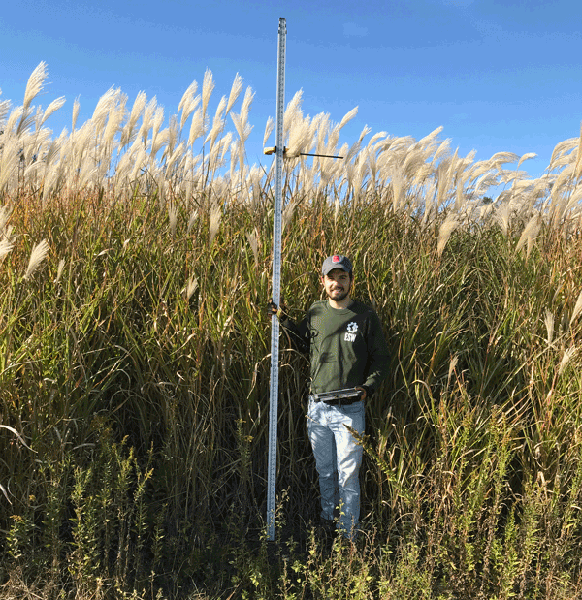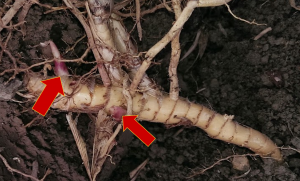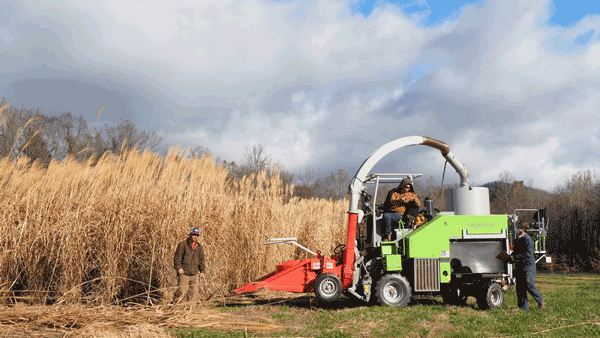What Is Miscanthus?
Miscanthus × giganteus — also called “giant miscanthus” or “elephant grass” — is a tall, perennial grass originally from Asia. It is considered a sterile hybrid that has been bred to not produce viable seeds. Instead, rhizomes are planted to establish the crop. The rhizome is an underground modified stem mass that puts out shoots and roots supporting new growth each year. This perennial crop takes two to three years to reach maturity, but established stands can reach upward of 12 feet tall with a very thick canopy (Pyter 2007) (Figure 1).
Miscanthus has shown potential for high dry-matter yields compared to other biomass crops, which could in turn lead to more efficient land use. In one study, switchgrass (Panicum virgatum) yielded 10.3 Mg/ha of biomass on average, while miscanthus yielded 22.4 Mg/ha (Heaton et al. 2004). In addition, miscanthus production has been associated with many environmental benefits, including protecting water quality, removing nutrient loads, stabilizing soil, and improving soil health (Bhardwaj et al. 2011; Hussain et al. 2019).
Many of the possible practical and environmental benefits that are associated with miscanthus production may be attractive to stakeholders who are interested in alternative land use options, particularly in areas considered to be marginal in crop productivity.
Marginal Lands: An Ideal Location?
Even with its increased consideration as a biofuel and potential for cellulosic yield, in most farming operations, adoption of a perennial crop like miscanthus may not meet the desired flexibility in high-yielding fields that annual crops provide. The inability to change crops from year to year may be a concern for some producers. However, marginal lands, areas that generate low to no profit from traditional row crops, appear to be an ideal landscape for this crop. Plantings in these locations would be an environmentally beneficial land use change.
Examples of marginal lands include areas with poor drainage, high water tables, steep slopes, and nonproductive soils, as well as zones within fields where crop yields are regularly low. As opposed to participating in conservation programs, in which the government provides financial incentives to landowners to take land out of production completely and convert it to forests, riparian buffers, or wetlands, miscanthus can be managed for profit. A miscanthus crop can be harvested and the material sold or used on the farm, depending on the type of operation. Miscanthus can produce high-yielding biomass feedstocks and, combined with the potentially significant environmental benefits, this crop could be well suited for livestock fodder in North Carolina and across the country.
Environmental Benefits
Miscanthus production has many positive environmental benefits. For example, relatively low levels of nutrients and chemicals are required to maintain a healthy stand, compared to many row crops. If miscanthus is being grown on land that once supported commodity crop production, the reduction in fertilizer and herbicide required would reduce costs and provide benefits to the local surface and groundwater supply. Nutrient content in agricultural runoff and drainage is a major problem in North Carolina and throughout the country. Multiple studies have shown the effectiveness of miscanthus at mitigating these negative environmental impacts when compared to traditional row cropping systems. Some of this research is summarized here.
A miscanthus crop is very nutrient-efficient because the nutrients in the biomass of the crop are transported back into the rhizome below the surface post-senescence, which occurs before harvesting, so those nutrients will be available after overwintering. Studies have indicated that nitrate loss into the groundwater during miscanthus production is negligible or, at the very least, significantly reduced compared to traditional cropping systems (Lesur et al. 2014). A study in Illinois found a 13X decrease in the amount of nitrate lost in a year due to leaching into the groundwater with planted miscanthus compared to a traditional corn-soybean rotation, with similar results for other nitrogen forms (McIsaac et al. 2010).
A North Carolina study comparing miscanthus with bermudagrass found that with the same nitrogen fertilizer input, the biomass yield of miscanthus can be as much as four times greater (Wang et al. 2018). It was further determined that more nitrogen is translocated into the belowground biomass if harvest is pushed to post-senescence compared to a pre- and post-senescence harvest system. Nitrogen removal rates generally decrease as harvest is delayed.
Another possible application of miscanthus is the management of animal waste applied to sprayfields. A North Carolina State University study compared the nutrient uptake and yields of miscanthus and switchgrass to bermudagrass on sprayfields located in eastern North Carolina (Wang et al. 2017). Bermudagrass was chosen as the comparison plant due to its known high nutrient uptake and its common use on sprayfields. The results of this study indicated that when harvest times are adjusted to limit groundwater leaching, miscanthus and switchgrass outperform bermudagrass both in yield and nutrient removal. Sprayfields can potentially add large nutrient loads to groundwater and surface water, and the use of biomass crops like miscanthus on such land could decrease these loads significantly.
The dense canopy of miscanthus can decrease the amount of runoff generated after rainfall events by intercepting rainfall. The large rhizome masses that expand beneath the soil surface can also help reduce soil erosion (Figure 2). Minimizing soil erosion protects water quality in nearby streams and improves soil quality in a given field. The perennial nature of miscanthus means that yearly tilling is not necessary, further decreasing soil loss compared to some other crops and improving soil stability (Jørgensen 2011).
Another indirect benefit of miscanthus using nutrients efficiently is a reduction in the amount of greenhouse gases like nitrous oxides and methane entering the atmosphere. Especially when the crop is unfertilized or fertilized at low levels, these greenhouse gases are produced in much lower amounts than with traditional crops (Voigt 2015).
In one study on highly saturated soils in Pennsylvania, unfertilized miscanthus produced 18.5 Mg/ha of dry aboveground biomass, compared with 11.4 Mg/ha for switchgrass fertilized at 50 kg N/ha (Rau et al. 2019). In addition, the miscanthus field emitted 244 g/ha of N2O compared to 1,113 g/ha for fertilized switchgrass and 820 g/ha for unfertilized switchgrass. This study highlights the ability of the crop to produce at a high level while having favorable environmental inputs and outputs.
Additional Information and Practical Considerations
The United States Department of Agriculture’s Natural Resources Conservation Service (NCRS) provides many resources for planting and managing Miscanthus x giganteus. One helpful publication is Planting and Managing Giant Miscanthus as a Biomass Energy Crop (Technical Note No. 4), available at the NRCS website. This document provides thorough detail about strategies for planting, harvesting (Figure 3), and in-season management of the crop. It further describes criteria and considerations for site selection and also outlines strategies to limit the dispersal of the crop outside the plot. The publication also provides some background on the biology of the species.
More information specifically targeted to North Carolina producers is pending — NC State faculty are leading a multidisciplinary research drive investigating the management, logistics, and sustainability of new varieties of miscanthus for production in North Carolina. For more information, see “Fueling the Future: Elephant Grass as Potential Biofuel Material (and More).”
References
Bhardwaj, A.K., T. Zenone, P. Jasrotia, G.P. Robertson, J. Chen, and S.K. Hamilton. 2011. “Water and Energy Footprints of Bioenergy Crop Production on Marginal Lands.” GCB-Bioenergy: Bioproducts for a Sustainable Bioeconomy 3, no. 3: 208–222. https://doi.org/10.1111/j.1757-1707.2010.01074.x
Carmenate, P., D. Clark, and E. Heaton. 2019. “Let's Plant Some Miscanthus!” Integrated Crop Management, Iowa State University Extension and Outreach.
Heaton, E., T. Voigt, and S.P. Long. 2004. “A Quantitative Review Comparing the Yields of Two Candidate C4 Perennial Biomass Crops in Relation to Nitrogen, Temperature and Water.” Biomass and Bioenergy 27, no. 1: 21–30. https://doi.org/10.1016/j.biombioe.2003.10.005
Hussain, M.Z., A.K. Bhardwaj, B. Basso, G.P. Robertson, and S.K. Hamilton. 2019. “Nitrate Leaching from Continuous corn, Perennial Grasses, and Poplar in the US Midwest.” Journal of Environmental Quality 48, no. 6: 1849–1855. https://doi.org/10.2134/jeq2019.04.0156
Jørgensen, U. 2011. “Benefits Versus Risks of Growing Biofuel Crops: The Case of Miscanthus.” Current Opinion in Environmental Sustainability 3, nos. 1-2: 24–30. https://doi.org/10.1016/j.cosust.2010.12.003
Lesur, C., M. Bazot, F. Bio-Beri, B. Mary, M.H. Jeuffroy, and C. Loyce. 2014. “Assessing Nitrate Leaching During the Three-First Years of Miscanthus × Giganteus from On-farm Measurements and Modeling.” GCB-Bioenergy: Bioproducts for a Sustainable Bioeconomy 6, no. 4: 439–449. https://doi.org/10.1111/gcbb.12066
McIsaac, G.F., M.B. David, and C.A. Mitchell. 2010. “Miscanthus and Switchgrass Production in Central Illinois: Impacts on Hydrology and Inorganic Nitrogen Leaching.” Journal of Environmental Quality 39, no. 5: 1790–1799. https://doi.org/10.2134/jeq2009.0497
Pyter, R., T.T.B. Voigt, E.A. Heaton, F.G. Dohleman, and S.P.S. Long. 2007. “Giant Miscanthus: Biomass Crop for Illinois.” In Issues in New Crops and New Uses, edited by J. Janick and A. Whipkey, 39–42. Alexandria, VA: ASHS Press.
Rau, B.M., P.R. Adler, C.J. Dell, D. Saha, and A.R. Kemanian. 2019. “Herbaceous Perennial Biomass Production on Frequently Saturated Marginal Soils: Influence on N2O Emissions and Shallow Groundwater.” Biomass and Bioenergy 122 (March): 90–98. https://doi.org/10.1016/j.biombioe.2019.01.023
Voigt, T.B. 2015. “Are the Environmental Benefits of Miscanthus × Giganteus Suggested by Early Studies of this Crop Supported by the Broader and Longer-term Contemporary Studies?” GCB-Bioenergy: Bioproducts for a Sustainable Bioeconomy 7, no. 4: 567–569. https://doi.org/10.1111/gcbb.12150
Wang, Z., T.J. Smyth, C.R. Crozier, R.J. Gehl, and A.J. Heitman 2018. “Yield and Nitrogen Removal of Bioenergy Grasses as Influenced by Nitrogen Rate and Harvest Management in the Coastal Plain Region of North Carolina.” Bioenergy Research 11, no. 1: 44–53. https://doi.org/10.1007/s12155-017-9876-x
Wang, Z., T.J. Smyth, C.R. Crozier, R.J. Gehl, and A.J. Heitman. 2017. “Yield and Nutrient Removal by Bioenergy Grasses on Swine Effluent Spray Fields in the Coastal Plain Region of North Carolina.” BioEnergy Research 10, no. 4: 979–991. https://doi.org/10.1007/s12155-017-9856-1
Publication date: July 28, 2021
AG-906
N.C. Cooperative Extension prohibits discrimination and harassment regardless of age, color, disability, family and marital status, gender identity, national origin, political beliefs, race, religion, sex (including pregnancy), sexual orientation and veteran status.



